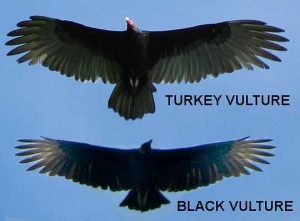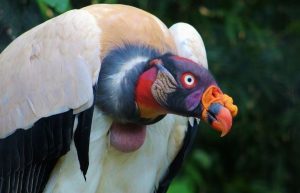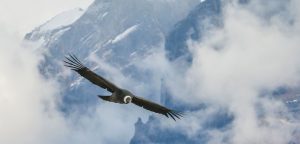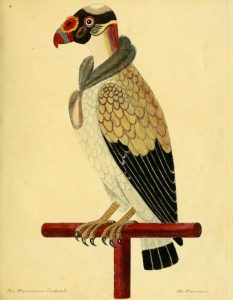Podcast: Play in new window | Download (Duration: 18:42 — 19.1MB)
This week we’ll learn about some vultures from North and South America–some living, some extinct, and one mystery! Thanks to Maureen and Grady for their suggestions!
Thanks also to Kat White for the Turkey Vulture Song that opens the podcast! If you’d like to buy her album “In the Eye of the Owl,” visit her website at katwhitemusic.com/
Further listening:
CritterCast episode 35 Turkey Vultures
How to tell a turkey vulture apart from a black vulture:

The king vulture has a very bright head:

The Andean condor soaring:

The painted vulture:

Show transcript:
Welcome to Strange Animals Podcast. I’m your host, Kate Shaw.
Way back in episode 40 we learned about the bearded vulture and some of its close relatives. This was a suggestion from Maureen, and I always meant to revisit vultures so we could learn about more vulture species. Then Grady wanted to know how long buzzards stay in the sky until they come down for food, and why do they soar for so long? That’s a great question that shows some good observation skills, so let’s go back to vultures and learn more about them.
Those of you listening in Europe may be wondering why I’m talking about buzzards in a vulture episode. That’s because we’re going to learn about new world vultures today, and in North America the general term for a vulture is a buzzard. In Europe, a buzzard is actually a type of eagle.
Before we get into the episode, though, I should mention that the intro music we heard is by Kat White, who was kind enough to let me use a snippet. It’s from the album “In the Eye of the Owl,” which is all about animals and so much fun I wanted to let everyone know about it. I’ll put a link in the show notes so you can find out more about the songs.
Kat also let me know about a turkey vulture named Lord Richard who lives in a park called Lindsay Wildlife Experience in California. Lord Richard just turned 45 years old and got a huge birthday party! So as you can see, vultures can live a long time in captivity, although usually not as long in the wild. Then again, the oldest verified vulture is an Andean condor born in captivity in 1930 who died in 2010 at the age of 79. Andean condors in the wild can live more than 50 years. This makes Lord Richard sound like a positive youngster.
New World vultures are native to the Americas and all of them are pretty big. In fact, condors are vultures and they’re extremely large birds. The New World vultures aren’t very closely related to each other but they all share some traits.
Vultures are scavengers that find dead animals to eat. The meat from dead animal carcasses is referred to as carrion. Vultures will also eat rotting fruit and garbage sometimes. Because they eat meat that is often spoiled, vultures have an extremely acidic digestive system that helps the bird digest its food quickly and kills off any bacteria that might make it sick. It also has beneficial bacteria in its digestive system that neutralize toxins.
But that’s not where the adaptations to eating carrion end. The vulture is a highly specialized bird. Most vultures don’t have many feathers on their heads, unlike other birds. If you’re snacking right now, you might want to pause this until you’re done. Quite often a vulture will actually stick its head into a rotting animal carcass to get at the, uh, softer parts. This means its head gets covered in rotting gunk and a lot of bacteria. If it had head feathers, they would be destroyed by bacteria.
One interesting thing about vultures of all kinds is that they actually help stop the spread of diseases like rabies and anthrax. Their digestive tract is so effective that it kills off viruses that caused the animal to die, so it’s actually beneficial to the environment in general and to farmers. Unfortunately, farmers don’t always know this and think vultures spread disease. Many vultures are protected species in most countries to stop farmers and other people from shooting them.
Quite often you’ll see a vulture perched somewhere up high with its wings spread. It does this to dry them when it’s been rainy or foggy, but also so that sunlight will help kill off any bacteria on the feathers. That’s another reason the vulture has no feathers on the head, so that sunlight can kill off any bacteria on its skin.
Vultures do some other gross stuff, like pee on their own legs. They do this to cool down in hot weather, since as the liquid droppings evaporate it cools the legs, and therefore cools the blood flowing through the legs, and therefore cools the vulture’s body temperature overall. But vultures also like to bathe in shallow water, which helps clean the skin and the feathers, and which of course washes any droppings off their legs.
Vultures also puke up what they’ve eaten if they feel threatened. This serves two purposes. The vulture is immediately much lighter and can fly away more easily, and the horrible stench of partially digested rotting meat may drive away a potential predator.
There are seven species of new world vulture alive today. The most common one is the turkey vulture, which lives throughout most of North and South America. The next most common is the American black vulture, which lives in South America up to the southern parts of North America. From a distance it can be hard to tell the two apart, but the black vulture has silvery tips on its wings.
The turkey vulture is the vulture most often referred to as a buzzard. It has a wingspan of about six feet, or over 1.8 meters, although it doesn’t weigh more than about five pounds at most, or 2.4 kg. It’s kind of a picky eater, surprisingly, and doesn’t like really rotten meat. It often hangs out with black vultures, but black vultures are more aggressive even though they’re a little smaller, and the turkey vulture will wait until the black vultures are done eating before it moves in to finish off what’s left.
Black vultures and turkey vultures aren’t very closely related and don’t really look very similar if you see them up close. The turkey vulture has a red head that looks a lot like a male turkey’s, which is where it gets its name. The black vulture has a gray head.
Unlike the turkey vulture, which almost exclusively eats carrion and rotting fruit and sometimes vegetables, the black vulture will also eat eggs and sometimes kills small animals, especially baby animals. It hunts in groups and can even kill newborn calves.
If you want to learn more about the turkey vulture, the Critter Cast Podcast has a really good episode all about it. I’ll put a link in the show notes in case you don’t already listen to Critter Cast.
The other new world vultures are mostly restricted to South America, except for the California condor. We’ll talk about condors in a minute. The king vulture is most common in South America although it also lives in parts of southern Mexico and in Central America. Unlike most vultures, which are mostly black, its feathers are mostly white with some gray and black markings. The skin of its bald head is brightly colored, with different individuals having different coloration—red, orange, yellow, purple, even blue, with an orange crest on its bill in adult birds. It also has a white eye with a red rim, and short bristles on the head. The ancient Maya people considered the king vulture a messenger of the gods, which is pretty neat.
The king vulture is big even for a vulture, with a wingspan of up to about 7 feet, or 2 meters, which makes sense since it’s most closely related to the Andean condor. It has a stronger bill than most vultures, which helps it tear open an animal carcass that other vulture species might not be able to access. Often, other vulture species will wait until a king vulture has opened a carcass and eaten its fill before they move in and eat too. It especially likes the skin and tougher meat of a carcass, and its tongue is raspy to help it pull meat off bones.
The king vulture’s ancestors lived farther north, into parts of North America, but went extinct around 2 ½ million years ago. We don’t really know all that much about the ancestors of the New World vultures, though, because they’re not very common in the fossil record. But the New World vultures are related to the terratorns, huge birds that are extinct now. We’ve discussed terratorns once before way back in episode 17, about the Thunderbird, but let’s discuss them again because they were incredible birds.
We have a decent number of terratorn remains from the La Brea Tar Pits and a few other places. The terratorns were bigger even than condors. A number of species lived throughout the Americas, with even the smaller species having an estimated wingspan of around 12 feet, or 3.8 meters. The largest species known, Argentavis magnificens, lived in South America around six million years ago. It’s estimated to have a wingspan of at least 20 feet, or 6 meters, and possibly as much as 26 feet, or 8 meters. That’s the size of a small aircraft.
Researchers think Argentavis was an efficient glider, hardly needing to flap its wings. But it wasn’t very maneuverable, so researchers also think it was probably a scavenger like modern vultures. Smaller terratorns may have been active hunters, more like eagles than vultures. Argentavis had strong legs and probably took off by running into the wind with its massive wings spread, sort of like an airplane taking off, so it didn’t have to flap its wings at all.
That brings us to Grady’s question about why and how buzzards soar for so long. Argentavis would have spent most of its time soaring, hardly ever needing to flap its wings. Its wings weren’t even very strong, and it might not even have been able to flap them when they were extended. The turkey vulture, or buzzard, is especially good at soaring for long periods of time, sometimes for hours, without needing to flap its wings.
If you’ve noticed, soaring birds like vultures, eagles, and hawks tend to fly in circles. There’s a reason for this. When the wind blows over a hill or mountain, it creates an updraft, a breeze that blows directly upward. Similarly, air rises from land that’s been warmed by the sun, causing columns of warm air called thermals. A soaring bird stays in these updrafts and thermals by flying in circles. Vultures also have wingtips where the feathers are spread out, so that each flight feather is separated from the next by a small space. Each of these feathers acts like a tiny wing of its own, which helps keep the vulture gliding forward and not downward. All this wind over the wingtip feathers causes a lot of pressure, though, and vultures have a special bone at the wingtip that helps strengthen and support the flight feathers. Soaring instead of flapping conserves a lot of energy, which is why vultures will soar for as long as they can, looking for food.
Most New World vultures have a good sense of smell, which is unusual for birds. The turkey vulture finds a lot of its food by smell. The black vulture doesn’t have nearly as good a sense of smell, though, and as a result it often follows turkey vultures to find carcasses, then bullies the turkey vultures out of the way to eat first. That’s not very nice, birds. In addition, the turkey vulture has keen eyesight, which helps it find dead animals that might not have started to smell yet.
So let’s talk about those condors now. There are two species of condor alive today, the California and the Andean. We covered the California condor in episode 44, extinct and back from the brink. The California condor actually went extinct in the wild in 1987, with only 22 birds alive in captivity, but an ongoing captive breeding program saved it from extinction and captive-bred birds started to be released into the wild in 1991. But there are still fewer than 500 individuals alive today, so it’s still in danger of extinction. The California condor only lives in a few small areas of western North America today, but around 40,000 years ago it lived throughout North America. Part of the reason it’s still so rare is that it reproduces very slowly. A pair doesn’t nest every year, and even when they do, the female only lays one egg. A young condor depends on its parents for a full year, both for food and to learn how to fly. It can take a young condor months to learn how to fly properly, and researchers sometimes observe awkward crash landings that are probably pretty funny, although maybe not so funny to the condor.
The California condor’s wingspan can be up to almost ten feet, or 3 meters. This is huge, but the Andean condor is even bigger. Its wingspan is nearly eleven feet, or 3.3 meters. The Andean condor lives in and near the Andes Mountains along the western coast of South America. It’s mostly black with silvery patches on the wings and a white ruff around the neck, and its head is gray in color but can flush reddish to communicate with other condors. The male also has a comb on the top of its head.
The Andean condor’s feet are adapted for walking, not fighting. Its feet aren’t very strong and its talons aren’t very sharp. It does sometimes kill small animals like rabbits, but its feet are so weak that it can’t use them to attack. Instead, it stabs the animal to death with its beak.
Like Argentavis, the Andean condor’s wings are built for soaring, not flapping. It can soar for hours without needing to flap its wings once, sometimes traveling hundreds of miles in a day to find food.
It’s a social bird that mates for life, and one of its courtship rituals is a hopping, flapping dance. Keep in mind that this is a bird with wings over five feet long. That would be a pretty impressive dance. The Andean condor nests high in the Andes Mountains on cliffs that predators can’t reach and lays one or two eggs.
Let’s go back to the king vulture now to finish up, because there’s a mystery associated with the king vulture. In the 1770s, a man named William Bartram traveled through Florida and took notes about the animals and plants he saw. He published a book of his travels in 1791 and in it, he included information about a bird he called a painted vulture. He said it was fairly common in Florida and that he’d even shot one himself. The description he gave sounds like a king vulture except that Bartram described its tail as white with a black tip, not entirely black.
But remember, the king vulture primarily lives in South America. It is known in the very southern parts of North America in Mexico, but not Florida. What’s going on?
Some people think Bartram included the painted vulture as a hoax. Some people think he got it mixed up with a different bird, the Northern caracara, a bird of prey which only looks slightly like a king vulture. Some people think there may have been a small population of king vultures in Florida at the time that later went extinct, possibly a subspecies of king vulture with a mostly white tail instead of all black.
Bartram wasn’t the only person who reported seeing the painted vulture. In 1734 an English naturalist and artist, Eleazar Albin, painted a vulture that looked almost identical to the one Bartram described 30-odd years later, tail and all. It’s not completely clear where Albin saw his bird, but as far as researchers can determine Bartram wasn’t aware of the painting. So it’s possible that a subspecies of king vulture once lived in Florida but went extinct soon after Bartram saw it. If he and Albin hadn’t documented it, no one alive today would have any idea the painted vulture ever existed.
You can find Strange Animals Podcast online at strangeanimalspodcast.blubrry.net. That’s blueberry without any E’s. We’re on Twitter at strangebeasties and have a facebook page at facebook.com/strangeanimalspodcast. If you have questions, comments, or suggestions for future episodes, email us at strangeanimalspodcast@gmail.com. We also have a Patreon if you’d like to support us that way.
Thanks for listening!